Ligand theory Study guides, Revision notes & Summaries
Looking for the best study guides, study notes and summaries about Ligand theory? On this page you'll find 260 study documents about Ligand theory.
Page 4 out of 260 results
Sort by
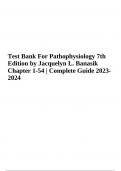
-
Test Bank For Pathophysiology 7th Edition By Jacquelyn L. Banasik Chapter 1-54 Latest Update2023-/2024
- Exam (elaborations) • 422 pages • 2023
-
- £29.93
- + learn more
Test Bank For Pathophysiology 7th Edition By Jacquelyn L. Banasik Chapter 1-54 Latest Update2023-/2024. An obese but otherwise healthy teen is given a prescription for a low-calorie diet and exercise program. This is an example of a. primary prevention. b. secondary prevention. c. tertiary prevention. d. disease treatment. CORRECT ANS: B Secondary prevention is the early detection, screening, and management of the disease such as prescribing diet and exercise for an individual who has al...
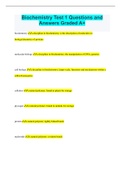
-
Biochemistry Test 1 Questions and Answers Graded A+
- Exam (elaborations) • 28 pages • 2023
-
- £8.19
- + learn more
Biochemistry Test 1 Questions and Answers Graded A+ biochemistry a discipline in biochemistry; is the description of molecules in biology/chemistry of proteins molecular biology a discipline in biochemistry; the manipulation of DNA, genetics cell biology a discipline in biochemistry; larger scale, functions and mechanisms within a cell/cell energetics cellulose a natural polymer; found in plants for storage glycogen a natural polymer; found in animals for storage protein a natural polymer; ...
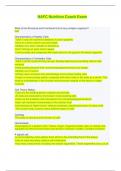
-
NAFC Nutrition Coach Exam - Complete Solutions (Answered)
- Exam (elaborations) • 32 pages • 2024
-
- £22.13
- + learn more
NAFC Nutrition Coach Exam - Complete Solutions (Answered) What is the Structural and Functional Unit of any complex organism? Cell Characteristics of Healthy Cells -Take in only the nutrients needed to function properly -Grow to a fairly uniform size and shape -Multiply only when needed or directed to -Don't infringe on each other's space -Communicate and cooperate with each other for the good of the whole organism Characteristics of Unhealthy Cells -Take in all the nutrients they can get, t...
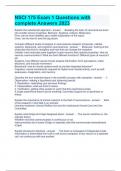
-
NSCI 175 Exam 1 Questions with complete Answers 2023
- Exam (elaborations) • 10 pages • 2023
- Available in package deal
-
- £17.21
- + learn more
NSCI 175 Exam 1 Questions with complete Answers 2023 Explain the reductionist approach Breaking the topic of neuroscience down into smaller pieces (Cognitive, Behavior, Systems, Cellular, Molecular). Pros: can be more detailed; get a better explanation of the topics Cons: can be hard to see the big picture Compare different levels of analysis in neuroscience research (molecular, cellular, systems, behavioral, and cognitive neuroscience) Molecular- looking at the molecules that bind t...
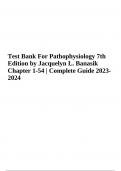
-
Test Bank For Pathophysiology 7th Edition by Jacquelyn L. Banasik Chapter 1-54 | Complete Guide 2023- 2024
- Exam (elaborations) • 422 pages • 2023
-
- £28.29
- + learn more
Test Bank For Pathophysiology 7th Edition by Jacquelyn L. Banasik Chapter 1-54 | Complete Guide 2023- 2024. C.Q. was recently exposed to group A hemolytic Streptococcus and subsequently developed a pharyngeal infection. His clinic examination reveals an oral temperature of 102.3°F, skin rash, dysphagia, and reddened throat mucosa with multiple pustules. He complains of sore throat, malaise, and joint stiffness. A throat culture is positive for Streptococcus, and antibiotics have been prescr...
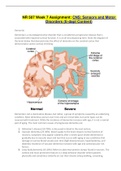
-
NR-507 Week 7 Assignment: CNS: Sensory and Motor Disorders (E-dapt Content) | aLREADY GRADED A
- Case • 27 pages • 2022
-
- £9.01
- 1x sold
- + learn more
NR 507 Week 7 Assignment: CNS: Sensory and Motor Disorders (E-dapt Content) Dementia Dementia is a neurodegenerative disorder that is considered a progressive disease that is associated with impai red cortical function. It is an all-encompassing term. Note the diagram of the brain below that demonstrates the effect of dementia on the cerebral cortex that demonstrates severe cortical shrinking: Dementia is not a stand-alone disease, but rather, a group of symptoms caused by an underlying conditio...
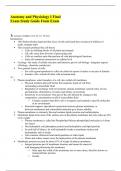
-
Anatomy and Physiology I Final Exam Study Guide From Exam
- Exam (elaborations) • 40 pages • 2024
-
- £14.26
- + learn more
Anatomy and Physiology I Final Exam Study Guide From Exam 1: Lesson 2 (slides 3-18, 21-31, 35-52) Introduction • 1665 Robert Hooke inspected thin slices of cork and found they consisted of millions of small, irregular units • This research produced the cell theory o Cells are building blocks of all plants and animals o All cells come from division of preexisting cells o Cells are smallest units that perform all vital physiological functions o Each cell maintains homeostasis at ce...
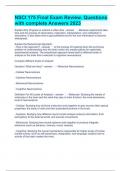
-
NSCI 175 Final Exam Review. Questions with complete Answers 2023
- Exam (elaborations) • 26 pages • 2023
- Available in package deal
-
- £20.08
- + learn more
NSCI 175 Final Exam Review. Questions with complete Answers 2023 Explain Why Progress in science is often slow -Because experiments take time and the process of observation, replication, interpretation, and verification is exhaustive. It also takes time to get published and for the new information to become widespread. Explain the Reductionist Approach: - How is the Approach? Is the process of breaking down the enormous problem of understanding how the brain works into smaller pieces ...
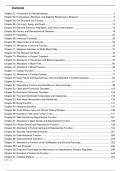
-
Test Bank Pathophysiology 7th Edition Banasik
- Exam (elaborations) • 347 pages • 2024
-
- £14.75
- + learn more
Test Bank Pathophysiology 7th Edition BanasikContents Chapter 01: Introduction to Pathophysiology ....................................................................................................... 2 Chapter 02: Homeostasis, Allostasis, and Adaptive Responses to Stressors ....................................................... 5 Chapter 03: Cell Structure and Function .............................................................................................................. 8 Chapter 04:...
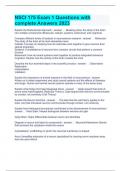
-
NSCI 175 Exam 1 Questions with complete Answers 2023
- Exam (elaborations) • 9 pages • 2023
- Available in package deal
-
- £16.39
- + learn more
NSCI 175 Exam 1 Questions with complete Answers 2023 Explain the Reductionist Approach Breaking down the study of the brain into multiple components (Molecular, cellular, systems, behavioral, and cognitive) Compare different levels of analysis in neuroscience research Molecular: The study of the brain at its most elementary level Cellular: Focuses on studying how all molecules work together to give neurons their special properties Systems: Constellations of neurons form complex circu...

How much did you already spend on Stuvia? Imagine there are plenty more of you out there paying for study notes, but this time YOU are the seller. Ka-ching! Discover all about earning on Stuvia


